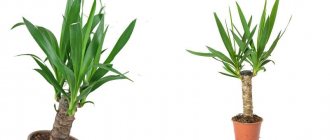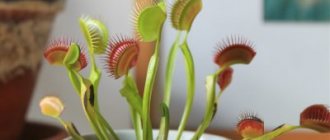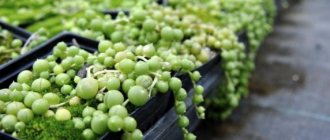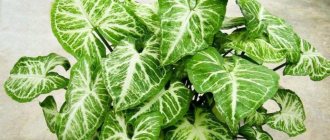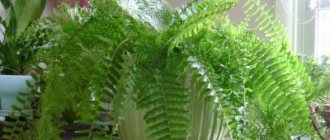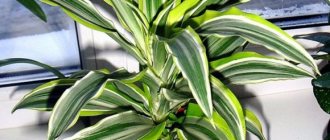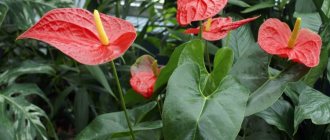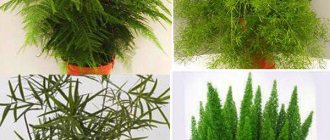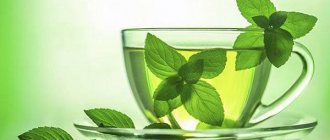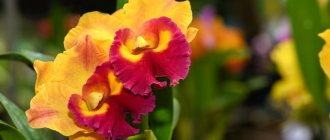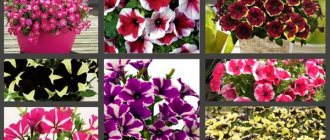Large tongue
Large-tongued groundsel - False ivy - Seneciomacroglossus.
Leaf succulent is a long-lived plant with creeping stems. The shoots can reach 1.5-3 m in length, branch slightly and slowly become woody.
The silhouette of the leaf blades follows the outlines of the spearhead and the leaves of true ivy. The inflorescences are on a long peduncle, very similar to field daisies. They have a yellow fuzzy center and light petals around them.
The variety Variegatus is distinguished by its two-colored leaves. Their dark green surface is painted with contrasting straw or smoky spots of arbitrary shape and location.
Flat-leaved
Flat-leaved - Senecio rhombifolius - Seneciorhombifolius.
Herbaceous medicinal perennial with tall, even stems.
The rhizome is steep, located in the upper layer of soil. The shoots are finely ribbed and dotted with an abundance of short hairs.
The leaves are elongated and wide, heart-shaped.
Lush inflorescences are corymbose corymbs consisting of a bunch of tiny lemon flowers.
After them, the fruit is formed in the form of a stretched cap.
Read more about the care, collection, drying, storage of flat-leaved groundsel, as well as its use in medicine, here.
Description
Trophy 2022 This ragwort surprised me right away, because plants with such abundant glandular and sticky pubescence are rarely found. Of my trophies, perhaps only the sticky tar left behind the same sensations. Of the ragworts and jacobeans present on the site, this ragwort is literally different to the touch, it is so sticky.
Flowers
Multi-flowered baskets. The middle flowers in the basket are tubular, with a five-lobed limb. The marginal flowers are false-ligulate, with a well-defined ligular limb with three teeth, clearly different from the median tubular ones. All the flowers in the basket are yellow. The marginal flowers are rare (12-13 on my specimens), and there is a noticeable distance between adjacent reeds. The tongues are short, curled down. Blooms from June to September.
All baskets on one individual are identical, collected in a common loose corymbose panicle.
The wrapper is double-row. The inner row is of well-developed leaves, the outer row is of smaller leaves, very different from the inner row. The outer leaves of the involucre are completely green (not half black). The involucre is densely covered with glandular hairs.
The diameter of the basket is 11-13 mm (excluding the folded edges of the reed flowers).
Wrapper length 11-12 mm, wrapper diameter 5-6 mm.
Leaves
The leaves are ovate or oblong (not heart-shaped or kidney-shaped), pinnately divided or pinnately lobed.
In the upper part of the leaf, the lobes are pinnately lobed or pinnately divided.
The top of the leaves is glandular-hairy, evenly and densely pubescent.
The bottom of the leaves is glandular-hairy, evenly and densely pubescent. There is no milky juice on the fractures.
The leaves are alternate.
Sheet length 11 cm, sheet width 6 cm.
Stem
The stem is erect, branched at the top, highly leafy. Flowering shoots with green, normally developed leaves. Annual, 15-60 cm high.
The stem is furrowed and pubescent. The plant is sticky with abundant glandular hairs.
Stem diameter 5 mm.
Fruit
Ovaries and fruits have hairy tufts with simple, non-pinnate hairs. The fruits are cylindrical, ribbed, pubescent achenes with a white tuft.
The receptacle is bare.
Habitat
It grows in pine forests, in clearings, clearings, along the sides of forest roads, and in peat mines. This small population was found in a clearing in the Arbekovsky forest, in a small hole along the road.
Application
Weed, found no use.
More photos:
See what else needs to be photographed for this article
.
In general, you need to do the following: reed, tubular, general appearance, wrapper leaves, root, seed size, seeds
Yakobeya Yakov
Jacobea Jacobea - Meadow glue - Seneciojacobaea - Jacobea vulgaris.
A very tall herbaceous plant, the stems of which can grow up to a meter in length.
The stems are bare or with very weak cobweb-like pubescence.
The leaves have an extremely bizarre shape, changing depending on their location.
The inflorescences, composed of small flowers, similar to cornflower, are collected in corymbose brooms or braids.
The number of petals can vary from 3 to 7. They are painted yellow-orange.
Common groundsel
Common ragwort - Golden ragwort - Seneciovulgaris.
A ubiquitous herbaceous pest.
It has thickened, erect stems with a smooth outer layer.
The leaf blades are large and elongated, usually elongated with lobes and marginal teeth.
The inflorescences are small, inconspicuous, bloom at the very top.
Amber tubular flowers are surrounded by a layer of emerald scales.
It is not only a noxious weed, but also toxic to animals.
At the same time, it contains substances that have hemostatic properties.
Contraindications and possible harm
The medicinal plant is beneficial when used in accordance with the instructions. The cross has certain restrictions on its use, which is due to the peculiarities of the chemical composition of the raw material. The poisonous weed is not used in the following cases:
- age under 18 years;
- pregnancy and lactation;
- diseases of the digestive system, adrenal glands;
- low pressure;
- glaucoma;
- individual intolerance.
Abuse of compounds containing weed can lead to damage to the cellular elements of the liver. The harm is caused by the presence of alkaloids in significant concentrations, long-term exposure to which causes disruption:
- stomach;
- intestines.
Important! Before taking products containing ragwort, you should consult a doctor. If signs of intoxication appear, including dry mouth, nausea and enlarged signs, you should stop taking the drugs and consult your doctor.
Ash cineraria
Ashy cineraria - Jacobaeamaritima - Silver or seaside cineraria.
An evergreen semi-shrub or shrub plant of modest size, not exceeding 50-60 cm.
Leaf blades are simple, heavily dissected.
They are painted in malachite color, which is almost invisible under the steel coating that covers the entire surface of the plant.
The flowers are small, look like daisies, and form baskets together.
The color of the petals is golden.
The leaves contain the compound seneciphylline, which perfectly relaxes muscle fibers.
The plant is used in outdoor interior design.
Artemisia
Artemisia ragwort - Carpathian Senecio - Senecioabrotanifolius.
A herbaceous perennial with low straight stems growing 20-35 cm in height.
Shoots can grow upward or horizontally, and slightly branch.
The leaves consist of a cluster of thin stripes, which is why they appear fluffy.
From 2 to 6 single flowers appear at the tip of each stem.
From the shaggy, carrot-colored center, sunny-colored petals extend downwards.
Cultivated for decorating gardens and alpine hills.
Ivy-shaped
Ivy ragwort - Senecioangulatus.
Guest from South Africa. An unpretentious, fast-growing plant with creeping shoots is often bred as a hanging plant.
The stems are plump and juicy, rich dark green or chestnut-red in color, densely leafy.
The leaf blades, growing, form a continuous carpet without the slightest gap.
They are distinguished by their noble pistachio coloring in deep tones, and outwardly they are hardly distinguishable from ivy itself.
The inflorescences are umbellate, multiple, intense saffron color.
Granta
Grant's ragwort - Seneciograntii.
Perennial succulent with thick roots - tubers.
The stems are fleshy, stretch upward, but under their own weight they bend and begin to crawl along the ground.
The leaves are oval, the petiole is widened, and the tip is pointed.
They are painted in a faded olive color; young ones are distinguished by a purple layer, which soon disappears.
During flowering, it delights with spherical inflorescences of bright color - tangerine or carmine.
Ragwort - use in folk medicine
Often, a decoction of godson root is prescribed for intestinal and acute stomach cramps, for convulsive constipation and exacerbation of ulcerative conditions, for bronchial asthma, angina pectoris, as well as for inflammation of the colon and renal colic.
The above-ground part of the plant and its roots contain biologically active components, the most important of which are considered:
- alkaloids: seneciphylline, platyphylline, sarracine, seneceonine, riddelline;
- ascorbic acid;
- routine;
- inulin;
- mineral salts;
- carotene.
In addition, the presented plant is indicated for paralysis and during attacks of chest pain. An alcoholic tincture of the root is used for recurring pain, 30 drops once a day.
Raspberry is also indicated for bronchial asthma and cerebral vascular spasms.
Medley Wood
Medley-Wood's godson - Seneciomedley-woodi.
Another leafy succulent that forms small shrubs.
The shoots can grow 70-90 cm in height. The stems are thick, erect, and do not branch.
The leaves are fleshy and juicy, egg-shaped.
The color is light green, hidden under a matte silver coating.
The inflorescences are small, formed at the top of the shoot, reminiscent of daisy flowers.
The petals are bright yellow, the middle can be red, chestnut, or reddish.
Types and varieties of succulents genus Krestovnik (Senecio)
Botanists have described quite a lot of species of the genus Senecio. Let's look at the most popular ones.
Succulent Ground grass (Senecio stapeliaeformis)
A stem variety of succulent. Miniature plant.
Raspberry stapeliiformes
Maximum height – up to 20 cm. In section – up to 30 centimeters.
Common groundsel (Senecio macroglossus)
This is a vine with oblong brownish stems.
Photo of the liana-like Rupaulin magnum
The culture is often confused with ordinary ivy. The leaves are triangular in shape and bright green. The flowers are usually yellow.
Rooting groundsel (Senecio radicans)
In the West it is also called “banana branch”. Height – up to 0.3-0.5 meters. Branched shoots.
The shape of the leaves of Rupaulus root resembles a small banana.
The leaves are glossy, their length is up to 1 centimeter. The view is ideal for hanging pots or baskets. The flowers are usually white.
Succulent Rowley's groundsel (Senecio rowleyanus)
It has a second name: “string of pearls”. The name comes from the British botanist Gordon Douglas Rowley. The succulent has an original appearance that resembles a necklace.
The Amazing Godson Rowley
The leaves are spherical in shape. Their diameter is up to 6 millimeters. Usually grown as a hanging crop. The flowers are also white.
Herrean's ragwort (Curio herreanus, Senecio herreianus)
This type of succulent is often compared to Rowley's ragwort.
To cancel from K. Rowley Gerrain's ragwort has elongated leaves
It is distinguished by elongated, ovoid and translucent veins. The leaves are large in shape, the flowers are a nondescript white shade.
Shooting groundsel (senecio scaposus)
Banana-shaped leaves. Color – silver.
Argentine ragus
The height of the bush is up to 0.3 meters. The bright flowers are yellowish in color and visually resemble chamomile.
Articulated groundsel (Senecio articulatus)
The plant is a deciduous shrub. Grows up to 0.5 meters in height.
Articulated ragwort
The branches are pale greenish. Their shape is round, thickness – up to 2 centimeters. The baskets form corymbs, the flowers are bright yellow.
Creeping
Creeping flower Senecioserpens.
Very low shrubs that gradually grow into a mat and densely cover the soil.
A perennial evergreen succulent that stores moisture in its leaves.
They are very fleshy, located on creeping stems. The plant is pale green and covered with a coating of gray and blue tones.
The inflorescences are milky-white baskets.
Diseases and pests
Improper care of ragwort is a common cause of plant disease.
Most often, these are gray rot and powdery mildew . Rot appears when there is high soil moisture, lack of light or in a too cool room.
Signs of the disease are dry spots with a yellow border.
For treatment, you need to treat the green pet with copper oxychloride and eliminate the causes of the disease.
Powdery mildew is characterized by a white coating on individual leaves and shoots of the plant.
Increased nitrogen content creates an additional risk of disease.
For healing, all diseased parts must be removed, and the entire plant must be treated with foundationazole in a 1:1 ratio with water.
Of the pests that most often parasitize gluing, three types can be distinguished :
- spider mite
- aphid
- mealyworms.
Spider mites only grow in dry and warm environments. Its presence is determined by the appearance of a thin cobweb on the inside of the leaf. The leaves themselves turn brown.
To kill the mite, the plant must be treated with Actellik. If there is a danger of infection, you need to humidify the air in the room and spray the ragwort with warm water.
Greenhouse aphids feed on the sap of leaves and shoots, causing them to turn yellow and dry. The inflorescences change color, and the buds may not bloom. The same control measures are used as against ticks.
Mealybugs (citrus and seaweed) lay eggs on senecio leaves, and the adults suck the sap from the leaves. An alcohol or soap solution can be used against insects.
If drastic measures are necessary, then karbofos emulsion will come to the rescue.
Acanthofolia
Acanthofolia - Senecioachanthifolius.
Always a green bush, living for many years, settling only in well-lit areas.
The leaves are patterned, picturesque in appearance, and a silver shiny coating only enhances the impression.
The shrub is often used as a decoration for flower beds and front gardens.
Rowley
Rowley's ragwort - String of Pearls - Seneciorowleyanus.
A very popular houseplant with a very distinctive appearance. It has creeping or drooping stems, which is why this type of kleinia can be used as a ground cover or hanging plant.
The main advantage is the original leaf-balls that look like large beads.
When it blooms, it produces a snow-white ball with chocolate stamens sticking out in different directions.
General rules for caring for succulents of the genus Raspberry at home
It is worth understanding that different types of Senecio grow in different climatic conditions and each of them requires different growing conditions. We will describe the general care requirements of these varieties of succulents. If you are interested in a specific species or variety, then go to the “species and varieties” section and look there for a link to an article on this plant.
The indoor flower Raspberry requires compliance with several growing rules. Then he will delight you with his beautiful forms.
Photo of Raspberry in a pot
Let's dwell on the general points in caring for the plant.
Priming
Loose soil is suitable for planting succulents of this genus, ideally with a neutral acidity level. It is important that the soil is well enriched with nutrients. You can prepare the composition yourself. To do this, use sheet soil, which is mixed with sand. The proportion is 2 to 1. If you don’t want to cook it yourself, you can buy a store-bought soil mixture that is suitable for cacti.
Lighting level
Choose locations where there is a lot of sunlight. The culture prefers to be exposed to direct ultraviolet rays. The ideal option would be a window facing West or East.
Temperature
In the warm season, the air temperature should be +22…26°C. When autumn comes, all types of ragwort require moving to a cool place. Optimal values +12…15°С. Do not allow the temperature to drop to +7.
Watering
Let us immediately note that the succulent does not need additional air humidification. In the hot season, you will need additional, but moderate watering. Watering is carried out 1-2 days after the top layer of soil dries. When autumn comes, moisture decreases significantly. In winter it is carried out extremely sparingly, or not at all. For irrigation, it is recommended to use settled soft water.
Fertilizer
The classic options that are used for succulents are suitable for feeding. The ideal interval is considered to be once every 14 days. At the same time, remember that fertilizing is applied only from the period from March to August.
Transfer
Young specimens are replanted every year. It is best to devote the spring time to this process. Adult crops are planted once every 2 or 3 years.
Articulated
Articulated gluena - Senecioarticulatus.
A deciduous shrub that looks like a succulent due to its very thick stems. Each is divided into small segments using constrictions.
When cut, the shoots are round and tend to branch heavily.
The leaves are carved, gray-green. Blooms with yellow corymbose baskets.
Determination formula
Genus:
all the baskets on one individual are the same - the baskets are multi-flowered - all the flowers in the basket are tubular, only false-ligulate at the edges;
plants without milky juice - flowering shoots with green, normally developed leaves - marginal flowers with a well-defined ligular bend, clearly different from the middle tubular ones - ovaries and fruits with hairy tufts - all flowers in the basket are yellow - two-row involucre, inner row of well-developed leaves , outer row of smaller leaves, very different from the inner row; leaves are not heart-shaped or kidney-shaped - species:
mono-biennial - leaves are pinnately divided or pinnately lobed - outer involucre leaves are completely green (not half black) - the plant is sticky due to abundant glandular hairs.
taking root
Rooting glue - Senecioradicans.
Long creeping succulent.
The stems are thin, the leaves are fleshy and elongated.
They have points at both ends, a dark marsh color and longitudinal stripes.
During the flowering period, single white baskets appear on long peduncles.
